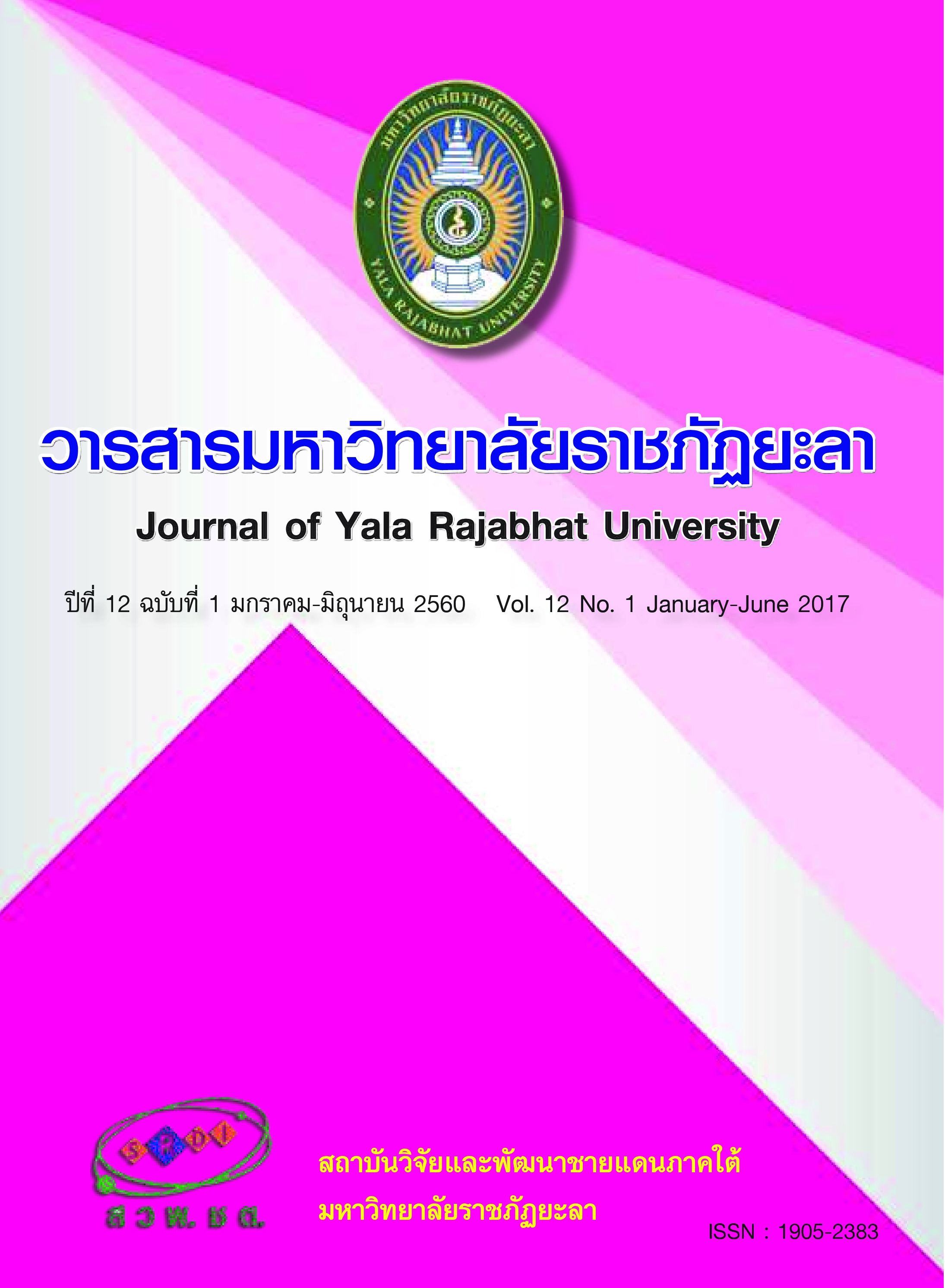การวิเคราะห์ต้นทุนและผลประกอบการของเกษตรกรชาวสวนยางกรณีศึกษา ตำบลปากล่อ อำเภอโคกโพธิ์ จังหวัดปัตตานี
Main Article Content
บทคัดย่อ
งานวิจัยนี้มีวัตถุประสงค์เพื่อศึกษาต้นทุนและผลประกอบการของเกษตรกรชาวสวนยางพาราเป็นการวิจัยเชิงสำรวจ จากกลุ่มตัวอย่าง 339 ตัวอย่าง โดยใช้แบบสอบถาม ผลการวิจัยพบว่าเกษตรกรชาวสวนยางส่วนใหญ่มีพื้นที่ในการปลูกยางและเปิดกรีดตั้งแต่ 5-10 ไร่ ใช้พันธุ์ยางพาราที่ปลูก RRIM600 จำหน่ายผลผลิตแบบยางก้นถ้วย (ขี้ยาง) โดยมีต้นทุนผันแปรเฉลี่ย 6,330.93 บาทต่อไร่ ต้นทุนคงที่เฉลี่ย 3,210.48 บาทต่อไร่ และส่วนของต้นทุนรวมโดยเฉลี่ย 9,541.41 บาทต่อไร่ผลผลิตและผลตอบแทนจากการปลูกยางพาราจะมีรายได้โดยเฉลี่ยต่อไร่ต่อปีของน้ำยางสดและยางก้นถ้วย(ขี้ยาง) เท่ากับ 14,970.19 บาท และส่งผลให้มีกำไรเฉลี่ยเท่ากับ 5,428.78 บาทต่อไร่ต่อปี ในการวิเคราะห์ผลตอบแทนในการปลูกยางพาราผลผลิตน้ำยางสดในจำนวน 10 ไร่ ตลอดอายุของการปลูกยางพารา 25 ปี จะมีระยะเวลาคืนทุน 11 ปี 2 เดือน 9 วัน มูลค่าปัจจุบันสุทธิเท่ากับ 1,168,438.59 บาท มีอัตราผลตอบแทนภายในร้อยละ 20.55 และอัตราส่วนของผลตอบแทนต่อต้นทุน 2.13 เท่า ซึ่งเชื่อว่าโครงการนี้เป็นโครงการที่ยอมรับได้ และในส่วนของผลผลิตยางก้นถ้วย(ขี้ยาง) ในจำนวน 10 ไร่ จะมีระยะเวลาคืนทุน 14 ปี 1 เดือน 10 วัน มูลค่าปัจจุบันสุทธิเท่ากับ 758,924.10 บาท มีอัตราผลตอบแทนภายในร้อยละ 20.44 และอัตราส่วนของผลตอบแทนต่อต้นทุน 1.74 เท่า ทั้งนี้เชื่อว่าโครงการนี้เป็นโครงการที่ยอมรับได้เช่นกัน เกษตรกรชาวสวนยางพารามีแนวคิดให้ภาครัฐเข้ามาส่งเสริมความรู้เกี่ยวกับการผลิตปุ๋ยเพื่อให้ลดต้นทุน รวมถึงการสนับสนุนและส่งเสริมอาชีพเสริมให้กับเกษตรกรเพื่อเพิ่มรายได้ ให้กับครัวเรือนอย่างยั่งยืนต่อไป
Article Details
บทความ ข้อมูล เนื้อหา รูปภาพ ฯลฯ ที่ได้รับการเผยแพร่ในวารสารมหาวิทยาลัยราชภัฏยะลานี้ ถือเป็นลิขสิทธิ์ของวารสารมหาวิทยาลัยราชภัฏยะลา หากบุคคลหรือหน่วยงานใดต้องการนำทั้งหมดหรือส่วนหนึ่งส่วนใดไปเผยแพร่ต่อหรือกระทำการใดๆ จะต้องได้รับอนุญาตเป็นลายลักษณ์อักษรจากวารสารมหาวิทยาลัยราชภัฏยะลาก่อนเท่านั้น
เอกสารอ้างอิง
2.Bank of Thailand. (2015). Rubber Situation in 2015 and 2016 trend [Online]. Retrieved June 6, 2016, from: www.bot.or.th/ReasearchPaper.pdf. (in Thai)
3.Bank of Thailand. (2016). Interest rate [Online]. Retrieved February 19, 2016, from: https://www.bot.or.th/thai/statistics/financialmarkets/interestrate/_layouts/ application/interest_rate/in_rate.aspx#.
(in Thai)
4.Chanthawong, A. (2015). Production Function, Cost and Benefit of Hevea Brasiliensis Farming in Surat Thani. Songklanakarin E-Journal of Social Sciences & Humanities, 21(1), 223-245. (in Thai)
5.Cooperative Auditing Department. (2015). Rubber price slump and how should rubber co-operative adapt? [Online]. Retrieved January 20, 2015, from: http://www.cad.go.th/ewt_news.php?nid=17194. (in Thai)
6.Office of Agricultural Extension and Development Region 5 Songkhla. (2014). The MRCF operation system for agricultural extension [Online]. Retrieved June 6, 2016, from: www.sdoae.doae.go.th/mrcf27/MRCF_pattani_rubber.pdf.
(in Thai)
7.Office of the National Economic and Social Development Board. (2008). Gross Regional and Provincial Products [Online]. Retrieved January 20, 2015, from: www.Nesdb.go.th/Default.aspx?tabid=96. (in Thai)
8.Office of the Rubber Replanting Aid Fund Khok Pho district. (2016). Agricultural information for rubber plantation. [Letter]. Office of the rector, Yala Rajabhat University. February 2, 2016. (in Thai)
9.Panpinij, S. (2008). A Study of Rubber Sheet Producing Business Potential in Lampang Province. Independent Study, Master of Economics. Chiang Mai University. (in Thai)
10.Pattani Provincial Office. (2006). The Pattani database 2005 [Online]. Retrieved January 20, 2015, from: http://poc.pattani.go.th/browse_report.php. (in Thai)
11.Phakhrueang, A. & Tewin, T. (2011). The rubber production in Thung Kluay sub-district, Phayao and the role of the sub-district administrative organization. Thai Universities for Healthy Public Policy, Thai Health Promotion Foundation. Phayoa: Faculty of Management and Information Science, University of Payao. (in Thai)
12.Rubber research institute, Rubber authority of Thailand. (2015). Rubber statistics [Online]. Retrieved June 6, 2016, from: www.rubberthai.com/statistic/stat_index.htm. (in Thai)
13.Sriwarin, P. & Sukkhua, J. (2008). Cost and Benefit of Hevea Brasiliensis Farming. Rubber Research Institute. Department of Agriculture [Online]. Retrieved February 25, 2015, from: www.doa.go.th/doaresearch/files/1095_2551.pdf.(in Thai)
14.Srilawong, O. (2008). Analysis of Cost and Return on Para Rubber Tree Plant: Case Study Amphoe Waritchaphum Sakon Nakhon Province. Independent Study, Master of Business Administration in Accounting. Rajamangala University
of Technology Thanyaburi. (in Thai)
15.Srisaart, B. (2002). Introduction to research. (Edition 7). Bangkok: Suwiriyasart. Toart, R., Jewsawat, R., Satjanant, S., Chanjareanchai, K., Vanaset, A., Pinitjitrasamut,M., et al. (2015). Project Analysis and Planning. Bangkok: Sukhothai Thammathirat Open University. (in Thai)
16.Wannachat, K., Yotakhong, S. & Keowan, B. (2012). Para Rubber Production and Marketing by Farmers in Song Dao District of Sakon Nakorn Province. The 2nd STOU Graduate Research Conference. September 4-5, 2012.
Bangkok: Sukhothai Kingdom Thammatirat University. (in Thai)
17.Wutthiwong, V. (2015). The Understanding of the Sufficiency Economy Philosophy for Implementation in the Local Community: A Case Study of Household Leaders at Sai khow Sub - District, Koh Phow District, Pattani Province.
Journal of Yala Rajabhat University, 10(2), 59-74. (in Thai)


